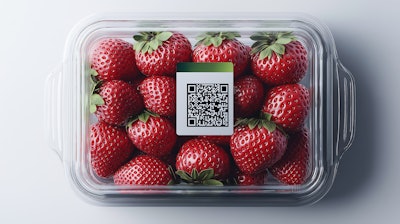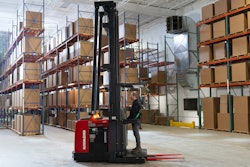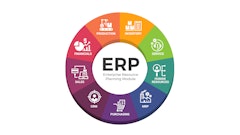
2D migration, also known as GS1 Sunrise 2027, is bringing about a new era for the global supply chain.
It’s the start of a new chapter in the global supply chain creating opportunities for efficiency, innovation, and value. The GS1 initiative is reshaping product marking and retail checkout systems. Leading FMCG producers and retailers have already committed to adopting the GS1 2D code standard and are actively driving its development. The challenge now lies in seamlessly integrating reliable 2D printing into existing production processes. Early adopters benefit from greater security, improved efficiency, and a clear competitive edge.
Regulations and timelines: Clarity is critical: What Sunrise 2027 means
By 2027, the cold food industry will enter the pilot phase with a gradual adoption of 2D codes. During this period, products may carry both traditional 1D barcodes and 2D codes.
At the end of 2027, all checkout systems must be upgraded to read GTINs in 2D codes.
From 2028 onward, manufacturers may decide to rely exclusively on 2D codes. However, this step will remain optional.
Common misconceptions
A widespread misconception is that linear barcodes will be banned in 2028. This is not the case — they will remain valid. The requirement to ensure readability applies only to point-of-sale (POS) systems, not to packaging.
Another misunderstanding is that human-readable codes will disappear. This is also false. In regulated industries such as pharmaceuticals and medical devices, as well as for consumer usability, alphanumeric data will remain essential.
Finally, migration is often seen as a one-time switch. In reality, it will be a multi-year transition in which 1D and 2D codes coexist.
Why do we need 2D barcodes?
Traditional 1D barcodes have been in use since 1974, but their limitations are now evident. In today’s data-driven, digital world, products require far more information than the 13-character GTIN carried in an EAN barcode. A 2D code can store up to 7,000 numeric characters, including: net weight, expiration dates, serial and batch numbers. All of this data can be embedded in a single 2D symbol that is faster and easier to scan from any angle.
Benefits of 2D codes
- Supply chain efficiency: better inventory management, faster recalls.
- Quality control: detailed production and batch information.
- Consumer engagement: access to nutritional values, sustainability information, and product authentication.
- Retail operations: improved POS efficiency and accurate price lookups.
Most common 2D code formats: QR codes and DataMatrix codes
The two most widely used 2D code formats are: QR codes (GS1 Digital Link URI) and GS1 DataMatrix codes (square or rectangular). Both formats provide high data density in a small space while remaining as fast to scan as linear barcodes.
Another important 2D GS1 format is the DotCode, a symbology specifically designed for high-speed printing applications, widely used in industries such as tobacco. The preferred printing method for DotCode is continuous inkjet (CIJ), which allows extremely fast and reliable marking even on challenging surfaces.
Time to get into the facts
There is no shortage of general information about GS1 Sunrise 2027. But to prepare effectively, industry leaders need clear, practical insights: What does the new system really mean? How will it affect production processes? Which printing technologies deliver the best results?
Here's a closer look at the technical and commercial realities of 2D migration and how to ensure a smooth transition.
Ensuring a smooth transition to 2D codes by selecting the right printing technology
In modern supply chains, all partners — from manufacturers to retailers — will rely on 2D codes for product identification. Retail systems are being upgraded, and POS equipment is adapting to the new standards. But if a simple scan of a 2D code at point of sale is going to do everything from price lookup functionality to sell by dates, companies need to know how best to print them.
Are 2D codes harder to print?
Yes — compared to linear barcodes, 2D codes are more complex. They contain more data and are made up of dense arrays of small modules. While most printers can technically apply a 2D code, the real challenge is printing with maximum readability, at high speed, and at low cost.
In fast-paced industrial production, selecting the right technology — and the right solution partner — is essential.
What is different about printing 2D codes?
2D barcodes are made up of a high-density arrangement of black squares, known as modules. Each module is 0.39 mm x 0.39 mm in size, and there is a big difference in how different printing technologies “fill in” this area. For example, the fine points of a laser printer (approximately 30 µm for UV laser printing) has to pass over it 13 times. A single drop of ink from a CIJ, however, fills the module completely.
What effect does this have on production speed?
This has a significant effect on production speed.
A UV laser printer requires 13 passes to print a single black square on a GS1 2D code: CIJ printers print the same barcode square with a single drop of ink.
Is point-of-sale legibility an issue with 2D codes?
If 2-dimensional codes are going to be easily read by the scanners used both within the supply chain and by customers in stores, there needs to be clear contrast between the white and the black modules.
The fine point size of laser systems is a drawback here too. Laser printers work by “scorching” the material, and the multiple passes required have a damaging effect on the substrate below. This can lead to discoloration of the white space alongside the black, reducing contrast and impairing readability.
CIJ, however, avoids such issues, by using high contrast inks. Some printers offer an innovative heat management feature to ensure consistent viscosity and performance of these specialist inks in varied temperature environments.
Why are pigmented inks important in 2D code printing?
Because the contrast between the modules is important to the readability of the code, pigmented inks can be very effective when printing against darker backgrounds. Pigmented opaque inks can be easily added to CIJ printers but this convenient option is not available to users of laser printers and thermal inkjet printers.
Will 2D codes affect the cost of printing?
The technology chosen to meet the demands of 2D codes will affect overall running costs.
For example, while laser printers cost significantly more to purchase than CIJ printers, it is often claimed that laser printing is cheaper in the long run because it doesn’t use ink. However, the opposite is true: the energy requirement for filtration systems and the frequent replacement of filters is a considerable hidden cost, and laser printers require much more electricity.
Add to this the lower purchase price of CIJ technology and it has some compelling cost advantages. Bear in mind also that low energy consumption and frugal use of solvent makes CIJ printers more sustainable, whereas laser printer users need to dispose of non-recyclable used filters every few months. You can have highly legible 2D codes whilst also reducing operating cost and CO2.
Are you ready for the 2D migration (GS1 Sunrise 2027) initiative?
The seamless transition to 2D codes is an amazing opportunity for producers to streamline logistics and improve the customer experience. And there is no reason that these benefits should come at a cost. CIJ printers offer an excellent way to make the most of the 2D barcode opportunity and greet the 2D migration with confidence.




















